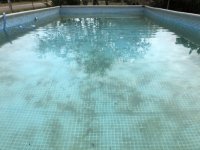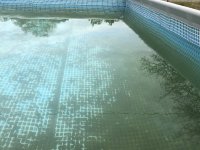James,Possibly calcium carbonate with various other compounds mixed in.
Did you add any calcium chloride or sodium carbonate?
Try dissolving in distilled water and then test using a biguanide test.
I used 12oz of distilled water and took an initial water reading:
ALK: 0
PH: 6.2 or less
BIGUANIDE: 0 ppm
I then put ~1.5tbsp of vacuumed scale into the water and stirred it around for about 5 mins. Subsequent water reading after stirring:
ALK: 40
PH: 6.5
BIGUANIDE: 0-2 ppm (color reading almost the same as pure distilled water)
Subsequent reading after letting sit idle for another 15mins:
ALK: 50
PH: 6.8
BIGUANIDE: 0-2 ppm
There seems to be some dissolving or breakdown into finer particles going on, albeit at a slow rate ... Not sure how much of that was a result of me stirring.
Interested in your thoughts ....
Last edited:




